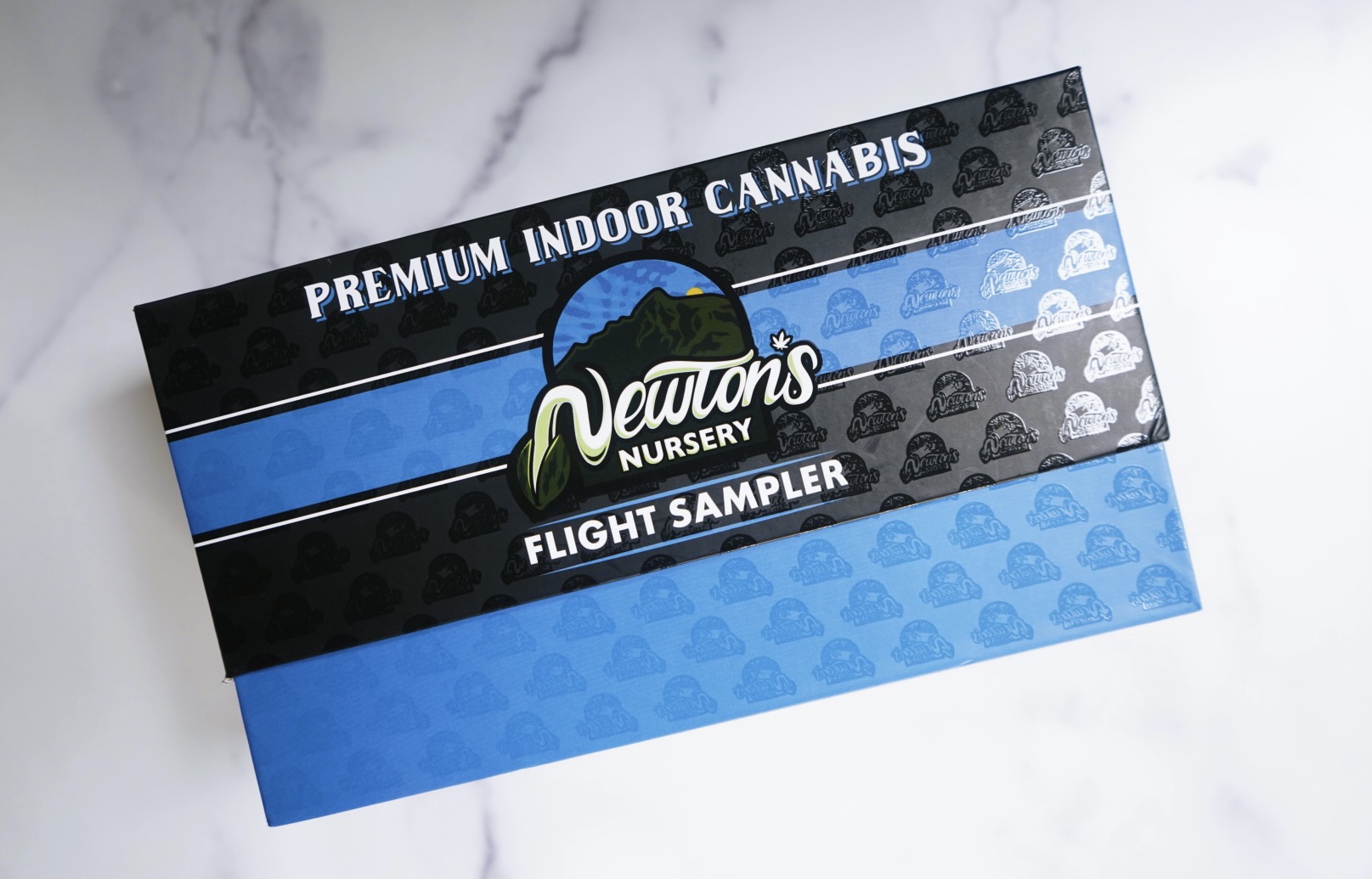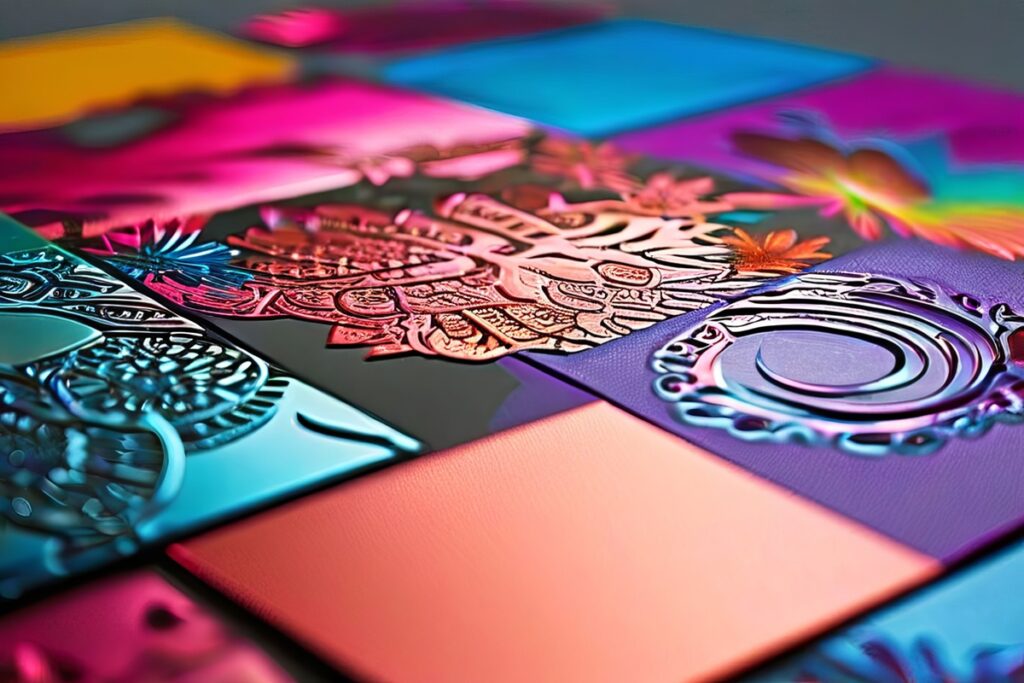What is Spot UV?

Spot UV, also known as spot gloss or spot varnish, is a print finishing method that adds a shiny, raised coating to specific parts of a design. This coating is cured with ultraviolet (UV) light, making the selected areas (such as logos or text) stand out with a glossy finish.
Spot UV works best when used on a matte or uncoated surface, creating a strong contrast. It’s often for:
- Business cards
- Brochures
- Postcards
- Product packaging
- Mylar bags
- Jar labels to give them a more polished and professional appearance.
We invite you to follow along as we take a deeper look into this printing technique and whether or not it’s right for your products.
Key Takeaways
- What Spot UV Is – A printing technique where a glossy, UV-cured coating is applied to specific areas (like logos or text) for a raised, eye-catching finish.
- Why It Matters for Branding – Spot UV adds luxury, tactile contrast, and visual focus, especially effective on custom packaging like mylar bags and cannabis jar labels.
- How to Use It Effectively – Use on smooth, thick substrates with a precise mask file; ideal for accentuating logos, titles, and brand elements without overwhelming the design.
How Does Spot UV Work?
The process begins during the design stage. A separate black-and-white file, called a UV mask, is created to show exactly where the glossy coating will go. This file acts as a guide, marking which areas (such as text, logos, or patterns) will receive the UV treatment.
Next, the full-color design is printed on the material using either digital or offset printing. This creates the base layer that includes all the images, colors, and text. Once the base layer is printed, the UV mask is used to apply a clear varnish to the marked spots. This is done through screen printing or with a plate, depending on the method used.
After the varnish, the print goes under ultraviolet (UV) lights. These lights cure the varnish instantly, turning it into a solid, glossy finish. The result is a high-shine effect that contrasts sharply with the matte or uncoated background.
Finally, the printed piece is trimmed, folded, or enhanced with other finishes like embossing. Each item is then checked for accuracy to make sure the UV coating aligns properly with the design.
Why Use Spot UV?
Spot UV printing offers both style and function. It helps designs stand out, feels good to the touch, and protects the surface. Here’s a closer look at the main reasons brands choose this technique:
- Visual Impact and Contrast
Spot UV highlights specific parts of a design (like logos, text, or graphics) by making them glossy against a matte background. This creates depth and draws attention to key elements, making your print look sharper and more professional. - Tactile Engagement
The raised glossy texture gives people something to feel as well as see. This physical detail adds sensory interest and makes the piece more memorable. - Durability
This technique isn’t just for looks. The UV coating adds a layer of protection that helps resist:- Moisture
- Scratches
- Fingerprints
- Smudges
- Fading
- Fast and Eco-Friendly
UV coatings cure instantly under ultraviolet light. They contain no volatile organic compounds (VOCs), so they’re safer for the environment and speed up production. - Stronger Brand Appeal
Spot UV sends a clear message of quality. When used on packaging, business cards, or promotional materials, it can help your brand look polished and high-end, without the need for more expensive materials.

Styles and Combinations
Spot UV has multiple uses to achieve unique visual and textural effects.
One popular method is Blind Spot UV, where the gloss is applied without any ink underneath. This creates a subtle, almost hidden pattern that becomes visible only when light hits it at the right angle. It’s a sleek way to add detail without overwhelming the design.
Another common approach is to apply the technique over matte lamination, matte varnish, or soft-touch finishes. The glossy areas stand out boldly against the dull background, creating a rich contrast that both looks and feels high-end. This combination enhances depth and gives printed materials a premium, polished finish.
Tips for Effective Spot UV Design
- Less is more – Highlight only the most important elements. Overusing it can make a design feel busy or messy.
- Choose the right substrate – Use smooth, thick paper or cardstock. Avoid thin or textured materials, which may not hold the coating well.
- Ensure alignment precision – Include crop marks and check that the print and varnish layers are in proper alignment. This avoids shifting or misprints.
- Plan for effect – Spot UV works best on logos, titles, and small accents. Avoid using it on large areas or small, detailed text that may lose clarity.
- Incorporate a mask in prepress – Always provide a separate, high-contrast mask file using solid black to indicate coated areas.
Spot UV vs. Other Finishes
| Finish | Gloss | Texture | Durability | Cost Level |
| Spot UV | High | Raised | Excellent | Mid-high |
| Emboss/Deboss | None | Deep | Good | High |
| Foil Stamping | Metallic | Smooth | Good | Mid-high |
| Full UV Coating | High (full) | Flat | Very Good | Mid |
| Matte Coating/Lamination | None | Soft/Flat | Good | Mid |
Spot UV brings a glossy tactile layer and durability inexplicably beyond embossing alone, with lower cost than full foil or full UV.
Cost and Limitations
Spot UV printing comes with added costs due to the extra steps required. Namely, this includes a digital mask file. Still, the added cost is minimal and provides you with a premium look, something worth considering when you’re managing your packaging budget.
The process also works best on flat, smooth surfaces. Textured or thick materials can cause the coating to apply unevenly, which may affect the final result.
In terms of production time, Spot UV adds steps like mask preparation and UV curing, which can extend turnaround. It’s important to plan and allow for extra time, especially when working with larger orders or tight deadlines.
Final Word
Spot UV is a powerful finishing technique that adds shine, texture, and a premium feel to printed materials and packaging.
It offers strong visual contrast, a pleasing tactile experience, and durable protection, all while using an eco-friendly curing process. This makes Spot UV a popular choice for brands looking to stand out in crowded markets, such as cannabis or luxury products.
Think you want to incorporate spot UV into your cannabis packaging? Unsure where to begin? Custom 420 Supply is here to help! We invite you to reach out through our contact page to learn more.
Frequently Asked Questions (FAQs)
Yes. Spot UV is purely a surface treatment applied to the outermost layer of printed packaging. It doesn’t come in direct contact with the cannabis product and is safe when applied correctly by a professional print partner.
Absolutely. Spot UV works well on flexible packaging like mylar bags, especially when the surface has a matte or soft-touch lamination underneath. It provides contrast and texture that grabs attention on shelves.
It can slightly increase production costs due to the extra print step and UV curing process. However, the perceived value and branding impact often outweigh the added expense, especially for premium or limited-edition products.
Yes, Spot UV is moisture-resistant and adds an extra layer of protection to the print. For products that require cold storage, it’s a great choice because it won’t smudge or deteriorate like some finishes.
